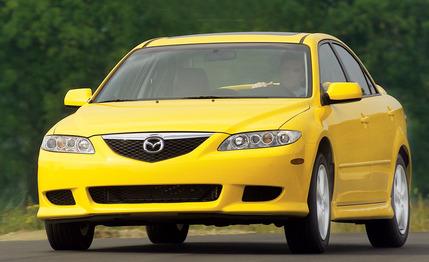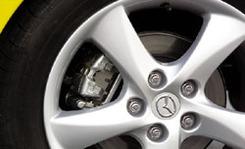 Road Test
Road Test
Let's play a word association game. Category: family sedans. Honda Accord: refined, efficient, ubiquitous. Chevy Impala: boring, homely, competent. Toyota Camry: phlegmatic, reliable, comfortable. Nissan Altima: powerful, edgy, atypical. Ford Taurus: Hertz, Budget, Payless. Mazda 626: Uh, do they still make that?
They did until recently, in niche-like numbers for the segment -- Hyundai's Sonata outsold the 626 last year. When we searched our archives for words describing the most recent 626, we didn't find many flattering ones. In a December 1997 assessment, we damned it faintly saying, "Generally, this is a softly defined, softly suspended, softly powered four-door that makes a soft case for shopping your Mazda store." We also indicted its toad-in-a-hole seating and dearth of features. In our final swipe at that soap-bar sedan, a June 1998 comparo, just 14 words were allotted to summarizing the 626's virtues.
The rest of the prose we hurled at that unloved car was taken as constructive criticism by the Mazda engineers who apparently set about addressing our complaints as though tailoring this new Mazda 6 s to satisfy our every sports-sedan whim.
"Softly defined?" There's nothing soft about the new 6. From its sharp prow, angular grille, rising beltline, and muscular haunches, this car hollers, "Hot rod!" from halfway across the parking lot. Our screaming Speed Yellow test car accentuates that message with its Sport package -- available on the four-cylinder 6 i or the V-6 6 s for about $900 -- which adds an aero kit, low-profile 17-inch wheels and tires, Optitron instruments, a black interior, and headlamp-cluster fog lights.
"Softly suspended?" Nope. Mazda scrapped the 626's Stay-Puft marshmallow struts for a suspension design that more closely approximates the Millenia's. An upper control arm, a lateral link, and a diagonal link help keep each front wheel vertical while introducing less friction than do struts. In back, trailing arms connect to the body via narrow, highly compliant bushings that soak up bumps in a straight line, and two lateral links and a toe-control link on each side provide firm resistance to lateral loading in corners. Aside from minor differences in spring rates to account for the different curb weights of four- and six-cylinder cars, only one level of suspension tuning is offered. It's Euro taut. Sport models further increase the tire footprint.

Low-profile coil springs and angled shock absorbers make for a compact rear suspension. As a result, the trunk swallows an impressive 15.2 cubic feet of luggage through a wide, low-lift-over opening. The longer 626 and Millenia held just 14.2 and 13.0 cubic feet, respectively, and the new Accord carries 14. That low-profile rear suspension also allowed the rear seat to move back, improving legroom by almost two inches.
"Softly powered?" Not anymore. Our flagship 6 s's 3.0-liter V-6 was born in America as the Duratec but schooled in Japan, where Mazda ginned up new cylinder heads with continuously variable intake-valve timing and swirl-inducing vanes cast in the intake runners. The pistons compress air and regular unleaded down at a 10.0:1 ratio. The cam covers are magnesium, and all accessories bolt directly to the aluminum block to quell the vibes. Peak output is 220 horsepower at 6300 rpm and 192 pound-feet at 5000 rpm -- that's respectable in the middling-sedan class, but it's 20 horses off the pace set by V-6 Accords and Altimas.